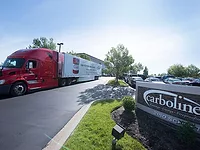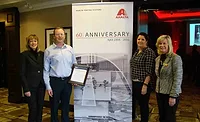After 60 Years New Paint, Same Look
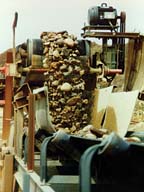
Products shipped from the company's Neponset, IL, manufacturing plant are as bright and shiny as ever. But the coating process to achieve this eye appeal has undergone some important changes that were implemented, not for its customers' benefit, but for the benefit of its employees.
For many years, an orange acrylic enamel was used to provide the distinctive look of the firm's products. Then, like many other businesses responding to competitive market conditions, the company became a just-in-time manufacturer. Now, Martin Engineering frequently produces many of its conveyor-belt cleaning systems, dust-management systems, vibration equipment and railcar unloading products to fill orders as they are received. The 45-minute drying time the paint required would need to be reduced.
In the plant
Cold-rolled steel parts fabricated for an order in one part of the factory, along with some purchased parts, are sent to a two-stage immersion washing station where they receive a phosphate wash and a rinse. The products are washed in the 350-gallon tanks for 12 to 15 minutes at temperatures of 140 to 160°F.Order filling is often a tightly timed process and, in many cases, an ambient-temperature air-drying time of only seven to 10 minutes is scheduled between the paint line and the assembly stations. Many of the subcomponents that make up a finished system are hand-assembled at the factory using power tools. If a part isn't dry, the assembly phase must wait, or the surface would get smudged and employees would have paint on their tools, hands and clothing.
The company also produces and coats some commonly used components to keep a minimum inventory on hand, and the time allowed to paint and assemble these parts is the same as for other parts.
To achieve the quick drying time, Martin Engineering first switched to a solventborne, air-dry lacquer coating. From a dry-time perspective, the switch was a success. From a human resource perspective, it was immediately viewed as a big problem.
The company's spacious production, warehousing and office areas are adjacent to each other in its 130,000-square-foot Neponset facility. When the switch to a solventborne coating was made, many of the 200 production employees and office staff started to complain about the odor that was permeating the entire facility.
Additional costs were incurred because the paint was quickly saturating the paint-booth filters and the company was required to soak them in water and then compact them in barrels to be removed by a disposal company. Paint line employees also found that the lacquer was more difficult to clean from the paint booth, the paint guns and other equipment, all of which had to be flushed out and cleaned by the end of the day, says Herb Whitmer, the company's manufacturing supervisor. "It was just unforgiving."
The firm's insurance carrier also was concerned because of the increased risk of fire resulting from the storage and application of the solventborne coating.
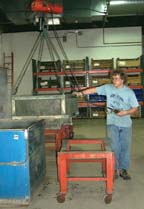
Back to the drawing board
It wasn't too long before MaryLynn Pronschinske, who is the company's human resource director and also serves as the corporate safety director, began prodding management to see if a waterborne coating was available that would meet the company's coating requirements without emitting an odor.Whitmer led the search for a possible waterborne replacement. While being odor-free was one of the goals, any new waterborne coating would also have to meet other quality criteria.
Certainly, it had to match the company's well-known orange color while resisting abrasion and other environmental wear and tear in the field to the same extent, if not better than, the lacquer.
While the company's immersion wash system removes almost all of the dirt and oils from components before they are painted, there are always some small, difficult-to-reach surfaces of some components that might not be completely cleaned during the wash process. The lacquer coating was not properly adhering to these surfaces, making them more susceptible to environmental reactions. Whitmer and his team wanted any replacement coating to cover these surfaces thoroughly.
In the fall of 2002, Martin invited Finishes Unlimited (Sugar Grove, IL), a company specializing in waterborne coatings, to analyze its coating situation and recommend a solution.
For the next 60 days, the product development staff at Finishes Unlimited developed coating formulations and tested them in its own labs and at Martin's factory. After testing was completed, Finishes Unlimited recommended an acrylic waterborne coating. The formulation had to be tweaked until the gloss was high enough. Also, the paint was drying from the outside in, rather than the other way around. Because of the short drying time, adhesion was affected, until a minor adjustment corrected the problem.
"So we made some adjustments, and now we have a nice, even cure rate," Whitmer says. "It's a little bit longer than what the lacquer was but not very noticeable because of our line speed [of about 5 fpm]."
Because the switch was from one liquid coating to another, the education process to train paint line employees to apply the new coating properly was relatively easy. "It did take a different mindset because when we sprayed the lacquer, or even the acrylic enamel, we did a tack coat first and then put a gloss coat on top," Whitmer says. "So we had to break that habit and go right into spraying as if it were a topcoat."
The production and office staff are happy because the waterborne coating is odorless. Not only has the smell disappeared, but the air quality in the production plant was improved because the switch reduced VOC levels emanating from the paint line by 80%. The current level of VOCs in the paint as supplied is 1.25 pounds per gallon.
Because the waterborne coating has a higher solids content (35%), it has proven to cover all component surfaces better than the lacquer, while providing longer abrasion resistance in the field. As an added bonus, the company is achieving more surface coverage per gallon of paint than was the case with the lacquer coating.
Better coverage was also achieved because the company switched from electrostatic guns to HVLP guns from Binks (Glendale Heights, IL), Whitmer says. With the electrostatic guns, there was more paint buildup on the hooks, grounding was reduced, and there was more overspray. The HVLP guns also reduced the Faraday cage effect.
The switch has even been welcomed outside the plant. The lead painter reports that though he paints in protective clothing, some paint gets on his clothes when items are removed from the conveyor belt or when he's cleaning the booth. But the waterborne paint is much easier to clean, and his work clothes don't wear as fast.
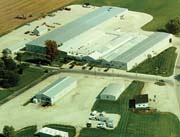
Sidebar
Martin Engineering is a global supplier of systems that make the handling of bulk materials cleaner, safer and more productive. Its products are used in industrial applications where difficulties in handling bulk materials lead to problems in production.Leading markets include coal-fired, electricity-generating facilities; coal, metallic and nonmetallic mineral mines; steel mills and foundries; pulp and paper mills; grain, food and chemical processing operations; aggregate, cement and concrete producers; and bulk transportation facilities.
Martin Engineering offers products and services in two basic groups. The Flow Aids group consists of equipment and services that improve the recovery of bulk solids from storage and maintain the movement of solids through the process. The line consists of vibrators, air cannons, railcar unloading systems and related components.
The Conveyor Products group provides methods to control fugitive material and improve the efficiency of belt conveyors. This group includes belt-cleaning systems, belt-support structures, skirtboard seals, belt-training devices and dust-suppression systems. Custom-engineered systems include air-supported belt conveyors and engineered "hood and spoon" chutes.
Martin Engineering was founded in 1944. The first product was the Vibrolator Pneumatic Ball Vibrator patented by Edwin Peterson and still used today for its original application of promoting the flow of bulk solid materials. The company's name comes from an earlier partnership used to manufacture and market Peterson's invention.
The corporate headquarters in Neponset, IL, is a 130,000-square-foot facility, including 18,700 square feet of office space, 102,500 square feet of manufacturing space, 3,500 square feet of research and development test facilities, and a 2,000-square-foot training center. The company has licensees and representatives around the world, including subsidiaries in Mexico, Brazil, France, Germany, Australia and Indonesia.
Internal manufacturing operations include the latest NC and CNC machining, stamping, punching, and forming machinery; welding and flame-cutting operations; urethane molding operations; painting, assembly, and packaging operations; and a comprehensive tool and die department. Martin Engineering routinely machines and fabricates a variety of materials, including ductile and gray iron, mild and stainless steel, and aluminum, as well as steel and aluminum castings, and molded polyurethane and plastics.
The company received ISO 9001 certification in 1995 and was recertified in 1998 and 2001.
Recently the company has acquired manufacturers such as Lyon, France-based VSR ProCD, a manufacturer of bulk solids-handling systems, and Witbank, South Africa-based Scorpio Conveyor Products Ltd., and has entered into strategic relationships with other companies.
Looking for a reprint of this article?
From high-res PDFs to custom plaques, order your copy today!





